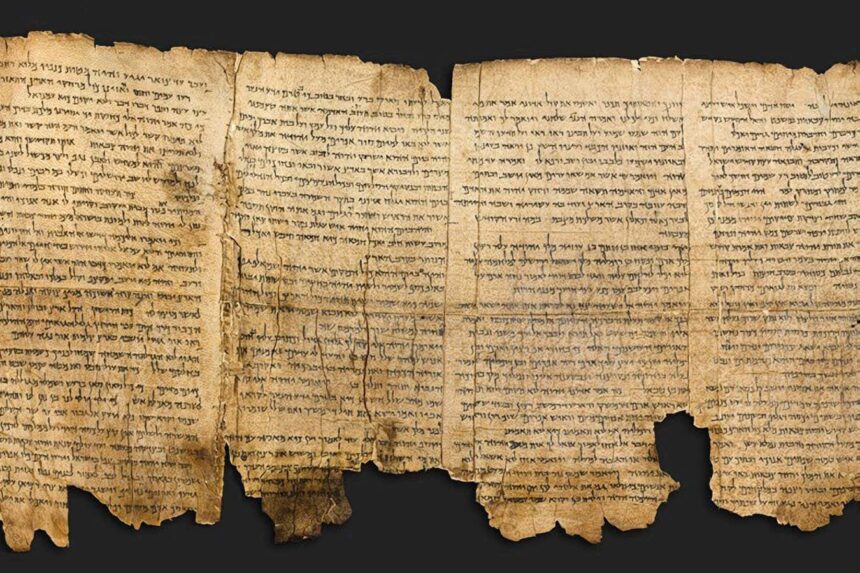
The Isaiah Dead Sea Scroll is thought to date to around 100 BC
Zev Radovan/Alamy
Some of the Dead Sea Scrolls may be up to a century older than previously thought, potentially revising our understanding of how these ancient texts were produced.
This new assessment, based on AI analysis of handwriting and modern radiocarbon dating techniques, even suggests that a few scrolls – like those containing the biblical books Daniel and Ecclesiastes – may be copies made during the lifetimes of the books’ original authors, says Mladen Popović at the University of Groningen in the Netherlands.
“I’m not saying they were written by the authors themselves,” he says. “But our study is a significant first step in rethinking what we know about literacy in ancient Judea, which now seems to have emerged before its political independence from the empires fighting to control it.”
The scrolls were discovered by shepherds in a cave on the north-west shore of the Dead Sea in 1947, leading to archaeological digs in the area that eventually uncovered nearly a thousand fragmented manuscripts hidden in 11 caves and a few other sites nearby. These Dead Sea Scrolls include the oldest known copies of some Old Testament books, and other ancient Jewish texts.
Scholars believed the scrolls were hidden to protect them from the Romans, who destroyed the Jewish temple in Jerusalem in AD 70. Based on the letterforms in the texts – mostly written in Hebrew or Aramaic – the scrolls were thought to date from as early as 150 BC. These assessments were based on comparisons with hand-dated administrative manuscripts from other sites from the 5th and 4th centuries BC and from the 1st and 2nd centuries AD, but nothing specific to the time period of the scrolls.
This view changed in the 1990s, however, when radiocarbon dating of a few dozen scroll fragments suggested a wider age range of about 500 years, starting in the 3rd century BC – to the surprise and scepticism of handwriting scholars.
Both methods have their flaws, says Popović. The early radiocarbon dating may have suffered from contamination, and its scope was too limited to offer a representative look across the scrolls. Handwriting analysis, meanwhile, is subject to human error, he says.
Modern radiocarbon dating methods have reduced contamination risks, providing accurate date ranges, says Popović, but they are also destructive, requiring sampling that damages these ancient artefacts.
Now, Popović and his colleagues have taken a new approach that aims to capture the best of both worlds. The researchers first radiocarbon-dated 27 manuscripts from the Dead Sea Scrolls, representing a range of different writing styles. They then trained an AI system to associate handwriting styles with specific dates from 24 of the tested scrolls.
Finally, to see how well the AI had learned, the researchers used it to date the three remaining manuscripts and found its responses aligned with the carbon dating, and it was able to estimate dates to within about 30 years.
The team then used the AI to analyse 135 of the nearly 1000 Dead Sea Scrolls and found that many were older than previously believed. One early script style, known as Hasmonaean, may have begun around 200 BC, a century earlier than scholars had thought. The later Herodian style also appears to date back 80 years earlier than expected. That means the two probably overlapped for several decades, contrary to traditional assumptions.
“The initial results that have been generated are nothing short of groundbreaking,” says Travis Williams at Tusculum University in Tennessee. If the trend continues among the remaining scrolls, he says, it could “force a rethink” of the way people considered writings and literacy at the time, not only within a complicated political context as Judaea became liberated, but also within religious hierarchies as literate people became less dependent on leaders for interpretation.
The fact that the authors of the Dead Sea Scrolls were reproducing recent texts – within a generation of the original author – is “almost unfathomable” compared with other examples of ancient literature, says Williams.
Even without the AI, Brent Nongbri at MF Norwegian School of Theology, Religion and Society in Oslo say he is impressed with the new radiocarbon dates and was surprised to see that a third of them did not align with those from previous handwriting analyses.
“The story that scholars tell about the history of this community depends in part upon the chronology of the scrolls,” he says. “So, some aspects of this story will probably need to be revisited.”
Topics:








